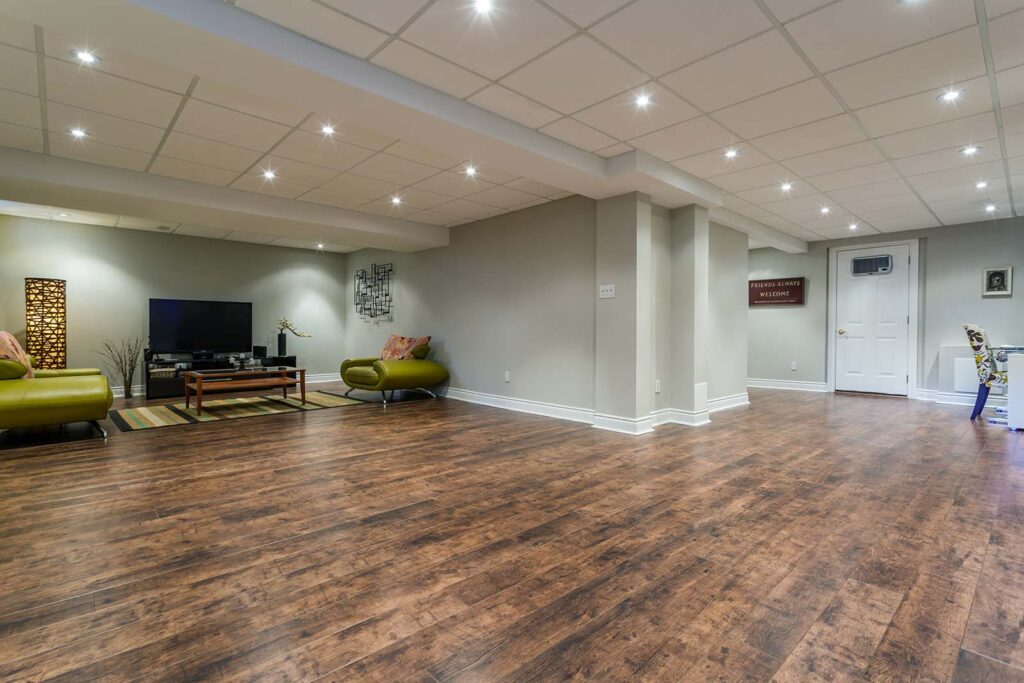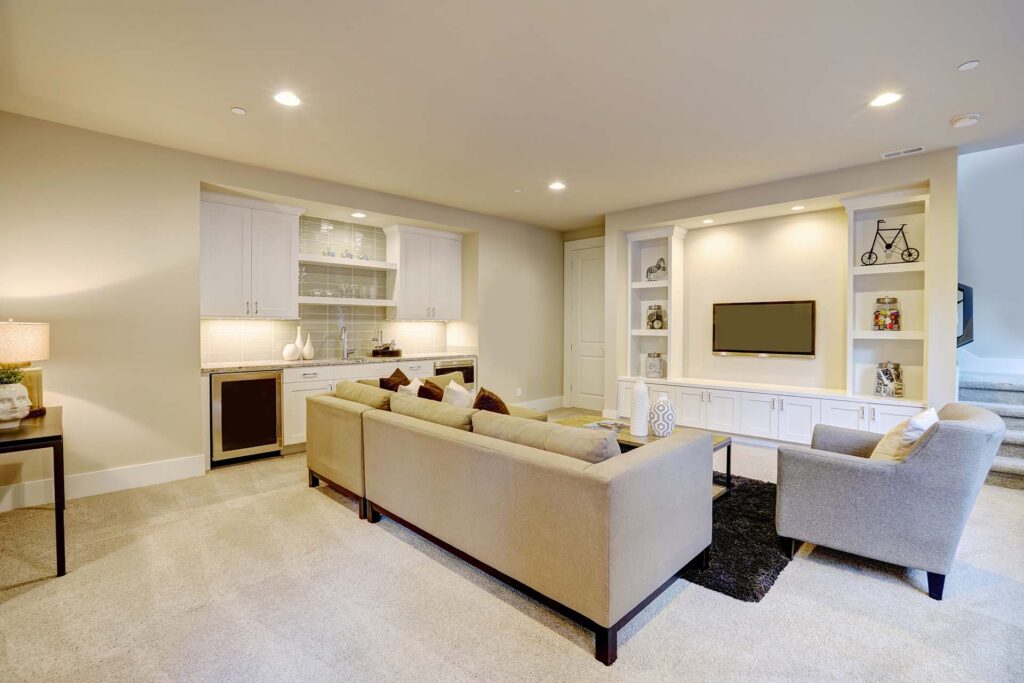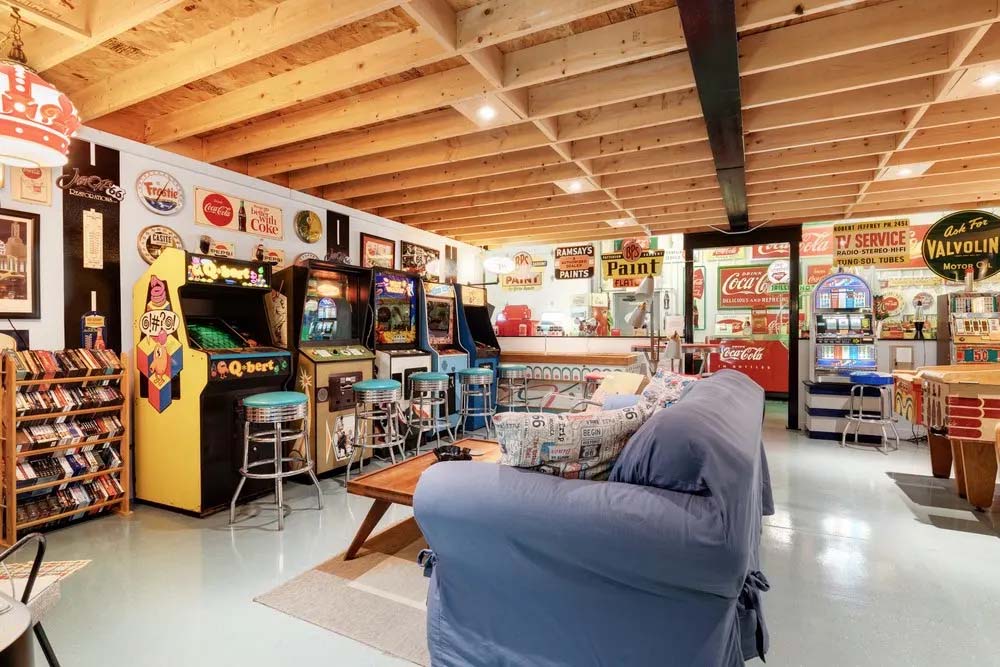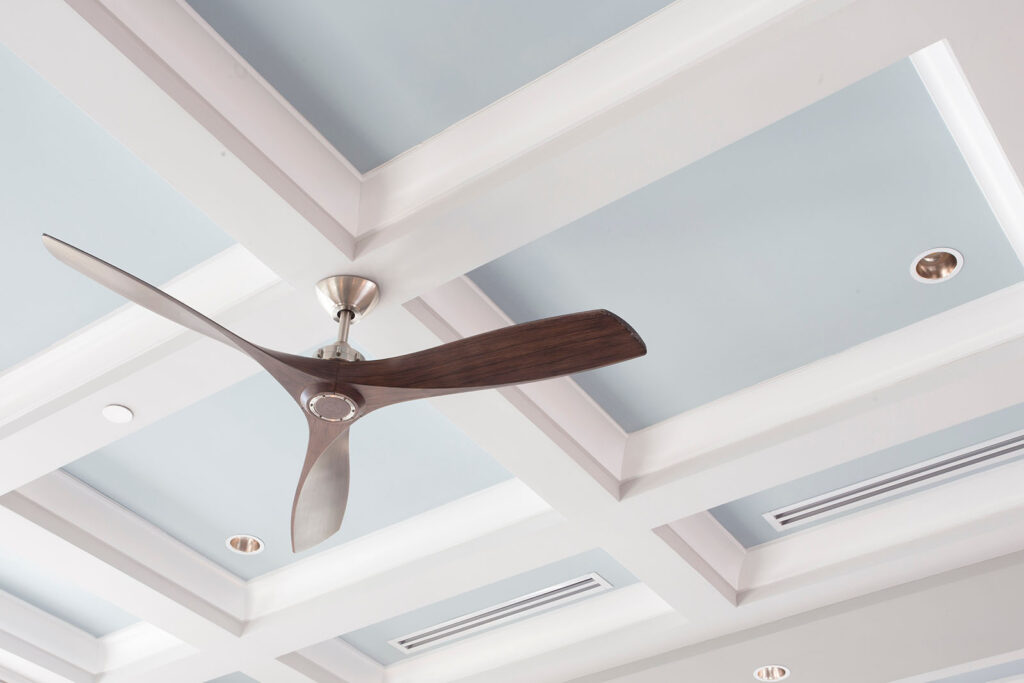Your basement ceiling is an often-overlooked aspect of your renovation. We get it, you don’t walk on it, you don’t hang art on it or really interact with it much in any way. This all makes your basement ceiling of the places where you may be tempted to save money. But there’s more to think about above your head than you think. Choosing the right ceiling treatment will impact your basement for years to come.
There are several ceiling styles that are commonly used in Canadian basements. Here are a few examples:

Drop ceilings
A suspended ceiling, also known as a drop ceiling, is a popular choice for many Canadian basements. This type of ceiling is made up of a grid of metal tracks and panels that hang from the ceiling joists. Suspended ceilings are relatively easy to install, and they provide access to pipes, ducts, and electrical wires that run above the ceiling.
Advantages of drop ceilings:
Easy access to utilities: A drop ceiling allows easy access to pipes, ducts, and electrical wires that run above the ceiling. If you need to make repairs or upgrades to your utilities in the future, a drop ceiling can make the process much easier and less disruptive.
Acoustic benefits: A drop ceiling can help to absorb sound and reduce noise transfer between floors. This can be particularly beneficial in homes with children, home offices, or other situations where noise reduction is important.
Aesthetically pleasing: A drop ceiling can provide a clean, finished look to your basement. There are a variety of different tile options available, allowing you to choose a style that matches your personal preferences and decor.
Disadvantages of drop ceilings:
Limited ceiling height: A drop ceiling can reduce the ceiling height in your basement, which may not be ideal if you have low ceilings to begin with. In some cases, a drop ceiling may not be a good option if you want to create a spacious, open feel in your basement.
Limited design options: While there are a variety of tile options available for drop ceilings, the design options are somewhat limited compared to other ceiling styles.
Reduced headroom: If your basement has low ceilings to begin with, a drop ceiling can further reduce headroom and make the space feel cramped.
Cost: Depending on the size of your basement and the type of tiles you choose, a drop ceiling can be more expensive than other ceiling options.

Drywall Ceilings
A drywall ceiling is another common option for Canadian basements. This type of ceiling involves installing sheets of drywall directly onto the ceiling joists. Drywall ceilings are more difficult to install than suspended ceilings, but they provide a smooth, seamless finish that many homeowners prefer.
Advantages of drywall ceilings:
Smooth, seamless finish: A drywall ceiling provides a smooth, seamless finish that many homeowners prefer over other ceiling styles. This can give your basement a more polished, upscale look.
Versatile design options: With a drywall ceiling, you can choose from a variety of design options, such as adding recessed lighting or creating different levels and angles.
More headroom: Drywall ceilings don’t take up as much headroom as a drop ceiling, which can be an advantage in basements with lower ceilings.
Cost: Drywall ceilings are often less expensive than other ceiling options, such as a coffered ceiling or an exposed ceiling.
Disadvantages of drywall ceilings:
More difficult to install: Installing a drywall ceiling can be more challenging than a drop ceiling or other ceiling options. This requires more skill and experience to get the job done properly.
Limited access to utilities: Unlike a drop ceiling, a drywall ceiling doesn’t provide easy access to pipes, ducts, and electrical wires that run above the ceiling. If you need to make repairs or upgrades to your utilities in the future, this can make the process more difficult and expensive.
Prone to moisture damage: Basements can be prone to moisture issues, and drywall is susceptible to mold and mildew growth if it gets wet. If you live in a humid climate or your basement is prone to flooding or moisture issues, a drywall ceiling may not be the best choice.
More dust and debris: Installing a drywall ceiling can create more dust and debris than other ceiling options, which can be a hassle to clean up.

Exposed Ceilings
An exposed ceiling is a style that involves leaving the ceiling joists and other structural elements exposed. This style has become increasingly popular in recent years, particularly in industrial or modern-style basements. Exposed ceilings provide a unique, raw aesthetic, but they can be more difficult to insulate and may require additional finishing work.
Advantages of exposed ceilings:
Cost savings: An exposed basement ceiling can be a cost-effective way to finish a basement since it eliminates the need for drywall, insulation, and other materials needed for a finished ceiling.
Easy access: With an exposed ceiling, you have easy access to electrical wiring, plumbing, and HVAC systems. This makes it easier to perform maintenance or make repairs when necessary.
Industrial look: Exposed ceilings can give a modern and industrial look to a space, which can be desirable for some homeowners.
Disadvantages of exposed ceilings:
Aesthetics: The exposed ceiling can look unfinished and unattractive, and it may not fit with the overall style of the home.
Sound insulation: An exposed ceiling can lead to sound transmission from the basement to the upper levels of the home, which can be disruptive to those living above.
Dust and debris: Exposed ceilings can collect dust and debris, which can be difficult to clean and maintain.

Coffered Ceilings
Coffered ceilings are a type of drop ceiling that features recessed panels or boxes. This style provides a more elegant, formal look, and can be a good option for homeowners who want to add some architectural interest to their basement.
These are just a few of the most common ceiling styles used in Canadian basements. The right option for your basement will depend on your personal preferences, budget, and the specific needs of your renovation project.
Advantages of coffered ceilings:
Aesthetic appeal: A coffered ceiling can add a touch of elegance and sophistication to your basement, and can help to create a focal point in the room.
Customizable: Coffered ceilings are highly customizable, so you can choose from a variety of styles, shapes, and sizes to fit your specific design preferences.
Improved acoustics: The recessed panels in a coffered ceiling can help to improve acoustics in the room by reducing echo and noise.
Hides ducts and pipes: A coffered ceiling can be a good option if you have unsightly ducts or pipes that you want to hide, as the recessed panels can help to conceal them.
Disadvantages of coffered ceilings:
Cost: Coffered ceilings are generally more expensive than other ceiling options, as they require more materials and labor to install.
Height restrictions: Coffered ceilings can take up more headroom than other ceiling options, so they may not be suitable for basements with low ceilings.
Installation time: Installing a coffered ceiling can be a time-consuming process, as it requires careful planning and precise installation to ensure that the panels are level and uniform.
Maintenance: Coffered ceilings can be more difficult to maintain than other ceiling options, as the recessed panels can trap dust and debris, making them harder to clean.
Thinking About Your Renovation? Contact the Borman Construction team for your basement renovations in Kitchener.


